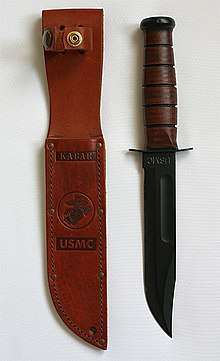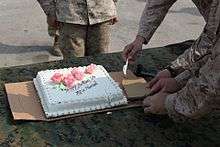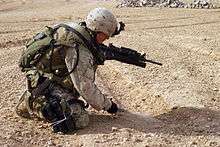Ka-Bar
Ka-Bar (trademarked as KA-BAR, pronounced /ˈkeɪ bɑːr/ ) is the contemporary popular name for the combat knife first adopted by the United States Marine Corps in November 1942 as the 1219C2 combat knife (later designated the USMC Mark 2 combat knife or Knife, Fighting Utility), and subsequently adopted by the United States Navy as the U.S. Navy utility knife, Mark 2.[1][2][3] Additionally, Ka-Bar is the name of a related knife manufacturing company, Ka-Bar Knives., Inc. (formerly Union Cutlery Co.), of Olean, New York, a subsidiary of the Cutco Corporation.
| (USMC) Knife, Fighting Utility (USN Mark 2 utility knife) | |
|---|---|
 USMC Ka-Bar knife | |
| Type | Knife |
| Place of origin | |
| Service history | |
| Used by | United States Marine Corps United States Navy United States Army |
| Wars | World War II Korean War Vietnam War Invasion of Grenada Operation Just Cause Gulf War War in Afghanistan Iraq War |
| Production history | |
| Designed | 23 November 1942 |
| Manufacturer | Camillus Cutlery Co. Union Cutlery Co. Pal Cutlery Co. Robeson (ShurEdge) Cutlery Co. Ontario Knife Co. |
| Produced | 1943–present |
| Specifications | |
| Mass | 0.7 pounds (320 g) |
| Length | 11 7⁄8 inches (30.16 cm) |
| Blade length | 7 inches (18 cm) |
| Blade type | Clip point |
| Hilt type | Stacked leather washers |
| Scabbard/sheath | Leather (USMC) or plastic (USN) |
Although Ka-Bar Knives, Inc., currently makes a wide variety of knives and cutlery, it is best known for the Ka-Bar Fighting/Utility knife, which has traditionally used a 7-inch (17.8 cm) 1095 carbon steel clip point blade and leather-washer handle.
History
After the United States' entry into World War II, complaints arose from Army soldiers[4][5] and Marines[6] issued World War I-era bronze or alloy-handled trench knives such as the U.S. Mark I trench knife for use in hand-to-hand fighting. The Mark I was relatively expensive and time-consuming to manufacture, and reports from the field indicated that the knife's large 'brass-knuckle' fingerguard handle made it difficult to secure in conventional scabbards while limiting the range of useful fighting grip positions.[7][8] Another criticism was that the Mark I's relatively thin blade was prone to breakage when used for common utility tasks such as cutting wire or opening ammunition crates and ration cans.[7] A final impetus came from the War Department, which had determined the need for a new multipurpose knife capable of fulfilling the roles of both a fighting and a utility knife, while at the same time conserving strategic metal resources.[9]
The Marine Corps authorized limited issuance of a fighting knife with a stiletto blade design, the Marine Raider Stiletto designed by Lt. Col. Clifford H. Shuey, a Marine Corps engineering officer. Shuey's pattern was essentially a copy of the Fairbairn–Sykes fighting knife with altered material specifications designed to reduce dependence on critical strategic metals. The Raider stiletto was initially issued to elite Marine forces, including the entire 1st Marine Raider Battalion commanded by Colonel Merritt A. Edson,[10] the USMC 1st Parachute Battalion, and to Marines of the 2nd Marine Raider Battalion commanded by Lt. Col. Evans F. Carlson.[11] Primarily intended as a thrusting (stabbing) weapon, the Marines of the 1st Raider battalion found the Raider stiletto to be well designed for silent killing, but was of little use for any other purpose, and too frail for general utility tasks.[10] After their first combat, many Marines in the 2nd Raider Battalion exchanged their Raider stilettos for No. 17 and No. 18 Collins general-purpose short machetes (machetes pequeños) purchased with unit funds.[11] The Collins machetes,[12] which superficially resembled a large Bowie knife, were also issued to some Army air crews as part of the Jungle Emergency Sustenance Kit of 1939.[11]
In the absence of suitable official-issue knives, a number of Marines deploying for combat in 1942 obtained their personal knives through private purchase, usually hunting/utility patterns such as Western States Cutlery Co.'s pre-war L76 and L77 pattern knives, both of which had 7-inch (180 mm) Bowie type clip blades and leather handles.[2] The Western States L77 was stocked at the San Diego Base Exchange at the onset of the war, and knives of this pattern were carried by many Marines in the 1st Marine Division as well as by Marine Raiders in the 2nd Marine Raider Battalion commanded by Lt. Col. Evans F. Carlson.[2][10]
In response to a specification requesting a modern individual fighting knife design for the U.S. Marines, ordnance and quartermaster officials requested submissions from several military knife and tool suppliers to develop a suitable fighting and utility knife for individual Marines, using the U.S. Navy Mark 1 utility knife and existing civilian hunting/utility knives such as Western's L77 as a basis for further improvements.[1] Working with Union Cutlery, USMC Colonel John M. Davis and Major Howard E. America contributed several important changes, including a longer, stronger blade, the introduction of a small fuller to lighten the blade, a peened pommel (later replaced by a pinned pommel), a straight (later, slightly curved) steel crossguard, and a stacked leather handle for better grip.[1][2] The blade, guard, and pommel were Parkerized instead of the bright polished steel of the prototype.[1] The design was given the designation of 1219C2[1] The knife used a thicker blade stock than that of the USN Mark 1 utility knife, and featured a clip point.[1] After extensive trials, the prototype was recommended for adoption.[13] The Marines' Quartermaster at the time initially refused to order the knives, but his decision was overruled by the Commandant.[14][15][16] The Marine Corps adopted the knife on November 23, 1942.[2]
The knife proved easy to manufacture, and the first run was shipped Jan. 27, 1943, by Camillus Cutlery Company.[2] After the U.S. Navy became disenchanted with blade failures on the USN Mark 1 utility knife, the latter service adopted the Ka-Bar as the US Navy Utility Knife, Mark 2.[17] The Marine Corps in turn re-designated the Ka-Bar as either the USMC Mark 2 Combat Knife, or simply the Knife, Fighting Utility. In naval service, the knife was used as a diving and utility knife from late 1943 onward, though the stacked leather handle tended to rot and disintegrate rapidly in saltwater.

The Marine Corps issued Ka-Bar fighting utility knife throughout Marine forces, with early deliveries going primarily to elite formations. In late 1943 the Ka-Bar replaced the Marine Raider Stiletto in service, a change welcomed by the Marines of Col. Edson's 1st Raider Battalion, who found the Raider stiletto ideal for silent killing but of little use for anything else.[10] As the knife went into large-scale production, the Marines issued the Ka-Bar Fighting Utility knife to reconnaissance and engineering units and to any Marine armed with the M1911 pistol, M1 carbine, BAR, or crew-served machine gun (rifle-armed Marines were typically issued a bayonet). Marines were often issued knives with "U.S.N. Mark 2" markings when Navy-issued Ka-Bar knives were all that was available.[2] By 1944 the Ka-Bar knife was issued to virtually any Marine in the combat branches who desired one, and was in use by Marine Corps close combat instructors for training new recruits.[18] Unlike the prior Marine Raider stiletto, Marines were taught to use their new knife primarily as a slashing weapon in the initial phases of hand-to-hand combat.[19]
As its new name implied, the "Knife, Fighting Utility" was designed from the outset as a dual-purpose knife: it was both an effective combat knife and a utility tool, well-suited to the type of jungle warfare encountered by Marines in the Pacific theater.[18] This dual-purpose design resulted in some initial criticism of the pattern as being less than ideal for knife fighting, but combat experience of returning veterans as well as reports from the battlefield dispelled doubts about its combat effectiveness.[18][20]
After the Second World War, the U.S. Navy and Marine Corps continued to use the Ka-Bar Fighting Utility knife. In addition to military contract knives, the knife was produced for the civilian market, and the pattern enjoyed some popularity as a general-purpose hunting and utility knife.[21]
Manufacturers and the "Ka-Bar" name
Camillus Cutlery Co., the first and largest manufacturer to supply the knife, produced over 1 million with "Camillus.N.Y." on the knife's crossguard.[2] Besides Camillus, the Union Cutlery Co., Robeson (ShurEdge) Cutlery Co., and PAL Cutlery Co. produced the Ka-Bar knife under military contract during World War II.[22]
After the end of World War II, Utica Cutlery Co., Conetta Cutlery Co., Camillus, and, around 1980, Ontario Knife Co., all produced the knife under contract for the U.S. military.[2] From 1945-1952, Weske Cutlery Co. of Sandusky, Ohio, purchased leftover and overrun parts from wartime knife contractors and assembled them for commercial sale, polishing out manufacturer and military markings, and fitting them with ungrooved leather handles.[23] Though W.R. Case made two prototype Ka-Bar knives as part of a contract submission in 1942-43, no contract was ever awarded to Case for the production of the knife. In 1992, Case would release a modern commemorative of these prototypes, the Case XX USMC Fighting Utility Knife. The Case knife is actually manufactured for Case by Ontario Knife Co.
The originator of the KA-BAR trademark, Union Cutlery Co, began using the name in 1923,[24] having received a letter from a fur trapper who had used the knife to kill a wounded bear which attacked him when his rifle jammed.[25] According to company records, the letter was only partially legible; "ka bar" could be read, as fragments of the phrase "kill a bear".[25][26][14][15][16][27] In 1923, the company adopted the name Ka-Bar from the "bear story" as its trademark.[24][25] From 1923, the KA-BAR trademark was used as a ricasso stamp by Union Cutlery Co. on its line of automatic switchblade pocket knives, including the KA-BAR Grizzly, KA-BAR Baby Grizzly, and KA-BAR Model 6110 Lever Release knives.[28] The company produced about 1 million knives with the trademark on the ricasso.[2] By 1944, Marines began referring to the knife as the "KA-BAR", regardless of manufacturer.[18][29] The popular designation of the knife may also have resulted from contact with Marine Corps close combat instructors in San Diego, who used the name when training recruits.[18] To capitalize on the popularity, Union Cutlery changed its name to Ka-Bar Cutlery Inc. in 1952. [2]
Service

Ka-Bar makes Army and Navy versions along with USMC versions.[1] They are the same as the Marine version except for different initials at the bottom of the blade and different symbols on the sheath. Marines today often treat the blades, guards and pommels with non-reflective black spray paint to reduce reflected light and give them additional protection against saltwater corrosion.[1] According to Ka-Bar, its 1095 Cro-Van, a moderate carbon and low chromium steel alloy, allows the blade to hold an edge very well. The "1095 Cro-Van" steel[30][31][32] used in the blades of contemporary Ka-Bars has a hardness of 56–58 HRC, while the guard and pommel are made from sintered 1095 carbon steel. Besides use as a fighting knife, the Ka-Bar has proved useful as a utility knife, for opening cans, digging trenches, and cutting wood, roots, wire, and cable.[1] In 1995, a version was released with a stainless steel blade, synthetic handle, and synthetic sheath marketed as "The Next Generation".[7] As of June 2012 the "Next Generation" models have been discontinued. In 1999, Ka-Bar released the "D2 Extreme" version of their fighting knife, coming with the same synthetic handle and sheath that was produced with the "Next Generation", but also a blade made from D2 tool steel for extra edge retention and slightly better corrosion resistance than 1095.
Ek Commando Knife Co.
In May 2014, the Ek Commando Knife Co. was purchased by Ka-Bar, with the firm selling its versions in 2015.
Becker Knife and Tool
In 2008, Ka-Bar began producing Ethan Becker's knife designs after his partnership with Camillus ended.
See also
References
- Walker, Greg (2001). KA-BAR: The Next Generation of the Ultimate Fighting Knife. Boulder, Colorado: Paladin Press. pp. 13–20, 77. ISBN 1-58160-120-4.
- Shackleford, Steve (ed.), Blade's Guide To Knives And Their Values (7th ed.), Iola, WI: Krause Publications, ISBN 1-4402-0387-3, ISBN 978-1-4402-0387-9 (2009), p. 387
- Petzal, David E., The 20 Best Knives Ever Made: The Jar-Head Favorite, Ka-Bar Marine Corps Fighting Knife, Field & Stream Magazine, Vol. CXIII, No. 2 (June 2008), p. 73: The USMC 1219C2 was first manufactured in January 1943 by the Camillus Cutlery Company of Camillus, New York
- KNIFE – U.S. KNIFE MODEL 1918 MKI TRENCH Springfield Armory Museum – Collection Record
- Canfield, Bruce N., U.S. INFANTRY WEAPONS OF WORLD WAR II, Lincoln, RI: Andrew Mowbray Publishers, ISBN 0-917218-67-1, ISBN 978-0-917218-67-5 (1994)
- Shackleford, Steve (2010-01-05). Blade's Guide to Knives & Their Values. p. 387. ISBN 978-1-4402-0387-9.
In addition to use by elite Army units such as the Rangers and U.S. airborne forces, some Marines serving in Marine Raider battalions during 1942 and 1943 carried U.S. Mark I trench knives.
- Walker (2001), p. 77
- Cassidy, William (January 1997). The Complete Book of Knife Fighting. p. 47. ISBN 978-0-87364-029-9.
- Blending Metals to Arm Our Fighting Men, Popular Science, Vol. 142 No. 6 (June 1943), p. 104: Demands for a modern fighting knife eventually resulted in the U.S. Army's adoption of the M3 trench knife in 1943.
- Alexander, Joseph H. (January 2000). Edson's Raiders: The 1st Marine Raider Battalion in World War II. p. 67. ISBN 1-55750-020-7.
- Rila, Carter, Military Myths and Misconceptions #3: The Little Machetes, Carter's Cutlery Commentarires (2005), retrieved 23 July 2011
- Rila, Carter: The Collins short machetes were commonly referred to by the 2nd Raiders as "Gung Ho Knives".
- Sledge, E.B. (2007). With the Old Breed: At Peleliu and Okinawa. New York: Random House. pp. 21–25. ISBN 978-0-89141-919-8.
- Rottman, Gordon L. (2006). US Marine Rifleman 1939-45: Pacific Theater. London: Osprey Publishing. p. 32. ISBN 978-1-84176-972-1.
- Rottman, Gordon L. (2007). FUBAR: soldier slang of World War II. London: Osprey Publishing. p. 67. ISBN 978-1-84603-175-5.
- Rottman, Gordon L.; Derrick Wright (2008). Hell in the Pacific: The Battle for Iwo Jima. London: Osprey Publishing. p. 46. ISBN 978-1-84603-335-3.
- Trzaska, Frank, The USN Mark 2, Knife World, (August 2006): The original specifications designated the knife as the "Fighting Knife Mark 2".
- Sledge, E. B. (2007). With the Old Breed: At Peleliu and Okinawa. p. 21–22. ISBN 978-0-89141-919-8.
We were introduced to the Marine's foxhole companion, the KA-BAR knife.
- MCRP 3-02B: Close Combat, Washington, D.C.: Department Of The Navy, Headquarters United States Marine Corps, 12 February 1999: "Marines use slashing techniques to close with an enemy. Slashing techniques distract or damage an opponent so Marines can close in."
- American Rifleman, C.B. Lister (ed.), Vol. 92, No. 1 (January 1944), p. 26: "Not an ideal fighting knife, it is nevertheless a highly effective weapon in jungle fighting, and, too, a sturdy tool in time of need for digging a fox hole or for opening a can of "D"ration (sic)."
- Kertzman, Joe (2007). Sporting Knives: Folders, Fixed Blades, Pocket, Military, Gent's Knives, Multi-Tools, Swords. Iola, WI: Krause Publications. p. 69. ISBN 978-0-87349-430-4.
- Shackleford, Steve (ed.), Blade's Guide To Knives And Their Values (7th ed.), Iola, WI: Krause Publications, ISBN 978-1-4402-0387-9, p. 387: Cattaraugus, Case, Western, Kinfolks, and others made huge numbers of 6-inch (150 mm) 225Q Quartermaster utility knives for the USN Quartermaster Department for opening and closing wooden crates; these knives are sometimes erroneously identified as Mark 2 Combat or Fighting Utility knives.
- Trzaska, Frank, "Rumors and Urban Legends", Knife World (March 2002)
- Shackleford, Steve (ed.), Blade's Guide To Knives And Their Values (7th ed.), Iola, WI: Krause Publications, ISBN 978-1-4402-0387-9, p. 143
- How KA-BAR Got Its Name
- Freeth, Nick (2005). Made in America: from Levis to Barbie to Google. St. Paul, MN: MBI Publishing Company. p. 32. ISBN 978-0-7603-2270-3.
- The legend of KA-BAR, Field & Stream Magazine, Vol. 83, No. 6 (October 1978), p.154
- Erickson, Mark, Antique American Switchblades, Chapter 22: KA-BAR, a trademark of Union Cutlery Co., Olean, NY, Krause Publications, ISBN 0-87349-753-8 (2004)
- Green, Michael, and Stewart, Greg, Weapons of the Modern Marines, Zenith Imprint Press, ISBN 0-7603-1697-X, 9780760316979 (2004), p. 19
- "Glossary". kabar.com. Retrieved 5 July 2016.
1095 Cro-Van Steel - Easy to sharpen, plain carbon steel used in knife making. Proven to be one of the most popular steels used in KA-BAR knives.
- "Full-size USMC KA-BAR, Straight Edge". kabar.com. Retrieved 5 July 2016.
- "Sharon Steel 1095 Cro-Van Knife Steel". zknives.com. Retrieved 5 July 2016.
1095 Cro-Van (Sharon Steel) - Based on 1095 steel, with the addition of small amounts of V, Mo, Ni, Cr. Improved wear resistance and toughness compared to 1095. Ka-Bar ... use[s] this steel in their knives. Ka-Bar under 1095 Cro-Van name...
External links
| Wikimedia Commons has media related to Ka-Bar. |